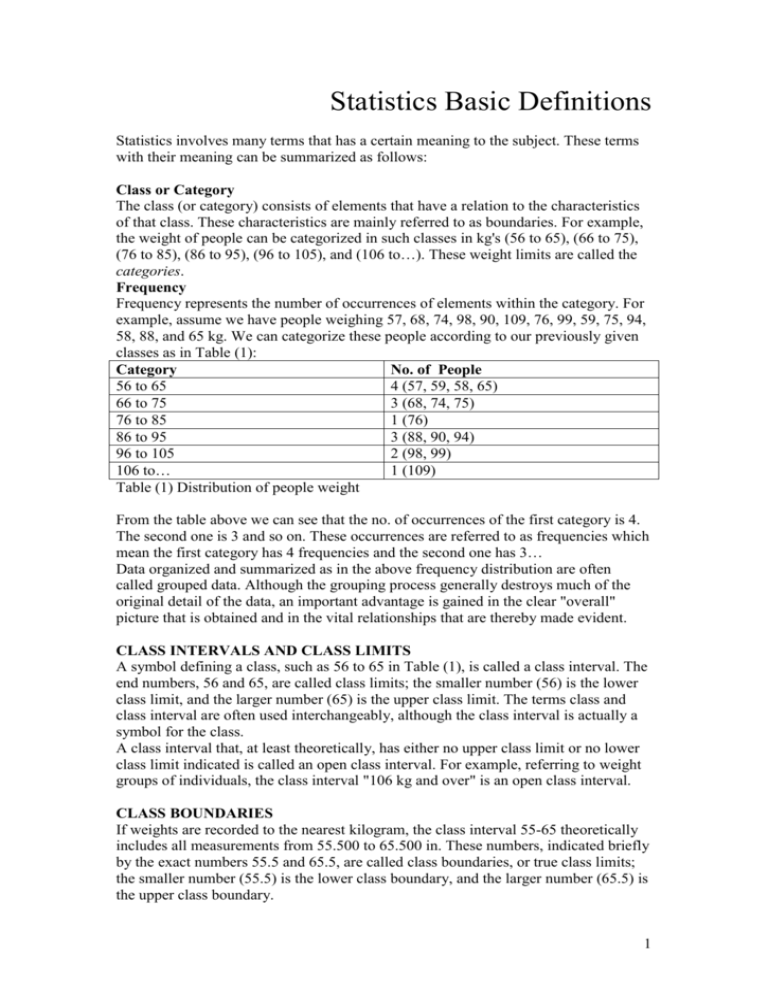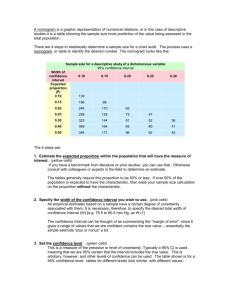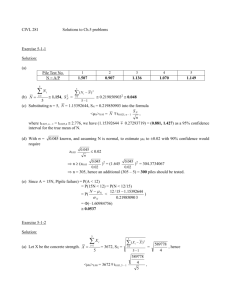Statistics Basic Definitions
advertisement

Statistics Basic Definitions Statistics involves many terms that has a certain meaning to the subject. These terms with their meaning can be summarized as follows: Class or Category The class (or category) consists of elements that have a relation to the characteristics of that class. These characteristics are mainly referred to as boundaries. For example, the weight of people can be categorized in such classes in kg's (56 to 65), (66 to 75), (76 to 85), (86 to 95), (96 to 105), and (106 to…). These weight limits are called the categories. Frequency Frequency represents the number of occurrences of elements within the category. For example, assume we have people weighing 57, 68, 74, 98, 90, 109, 76, 99, 59, 75, 94, 58, 88, and 65 kg. We can categorize these people according to our previously given classes as in Table (1): Category No. of People 56 to 65 4 (57, 59, 58, 65) 66 to 75 3 (68, 74, 75) 76 to 85 1 (76) 86 to 95 3 (88, 90, 94) 96 to 105 2 (98, 99) 106 to… 1 (109) Table (1) Distribution of people weight From the table above we can see that the no. of occurrences of the first category is 4. The second one is 3 and so on. These occurrences are referred to as frequencies which mean the first category has 4 frequencies and the second one has 3… Data organized and summarized as in the above frequency distribution are often called grouped data. Although the grouping process generally destroys much of the original detail of the data, an important advantage is gained in the clear "overall" picture that is obtained and in the vital relationships that are thereby made evident. CLASS INTERVALS AND CLASS LIMITS A symbol defining a class, such as 56 to 65 in Table (1), is called a class interval. The end numbers, 56 and 65, are called class limits; the smaller number (56) is the lower class limit, and the larger number (65) is the upper class limit. The terms class and class interval are often used interchangeably, although the class interval is actually a symbol for the class. A class interval that, at least theoretically, has either no upper class limit or no lower class limit indicated is called an open class interval. For example, referring to weight groups of individuals, the class interval "106 kg and over" is an open class interval. CLASS BOUNDARIES If weights are recorded to the nearest kilogram, the class interval 55-65 theoretically includes all measurements from 55.500 to 65.500 in. These numbers, indicated briefly by the exact numbers 55.5 and 65.5, are called class boundaries, or true class limits; the smaller number (55.5) is the lower class boundary, and the larger number (65.5) is the upper class boundary. 1 In practice, the class boundaries are obtained by adding the upper limit of one class interval to the lower limit of the next-higher class interval and dividing by 2. Sometimes, class boundaries are used to symbolize classes. For example, the various classes in the first column of Table (1 could be indicated by 55.5-65.5, 65.5-75.5, etc. To avoid ambiguity in using such notation, class boundaries should not coincide with actual observations. Thus if an observation were 65.5, it would not be possible to decide whether it belonged to the class interval 55.5-65.5 or 65.5-75.5. THE SIZE, OR WIDTH, OF A CLASS INTERVAL The size, or width, of a class interval is the difference between the lower and upper class boundaries and is also referred to as the class width, class she, or class length. If all class intervals of a frequency distribution have equal widths, this common width is denoted by c. In such case c is equal to the difference between two successive lower class limits or two successive upper class limits. For the data of Table (1), for example, the class interval is c = 65.5 - 55.5 = 75.5 - 65.5=10. THE CLASS MARK The class mark is the midpoint of the class interval and is obtained by adding the lower and upper class limits and dividing by 2. Thus the class mark of the interval 5665 is (56 + 65)/2 = 60.5. The class mark is also called the class midpoint. For purposes of further mathematical analysis, all observations belonging to a given class interval are assumed to coincide with the class mark. Thus all weights in the class interval 56-65 in are considered to be 60.5 kg. 2









